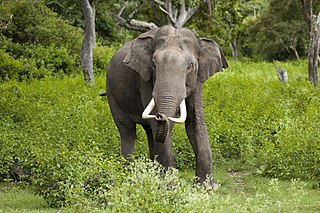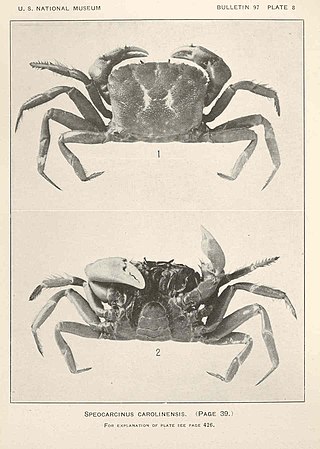Related Research Articles

Elephantidae is a family of large, herbivorous proboscidean mammals collectively called elephants and mammoths. These are large terrestrial mammals with a snout modified into a trunk and teeth modified into tusks. Most genera and species in the family are extinct. Only two genera, Loxodonta and Elephas, are living.

Cetotherium is an extinct genus of baleen whales from the family Cetotheriidae.
Paleontology or palaeontology is the study of prehistoric life forms on Earth through the examination of plant and animal fossils. This includes the study of body fossils, tracks (ichnites), burrows, cast-off parts, fossilised feces (coprolites), palynomorphs and chemical residues. Because humans have encountered fossils for millennia, paleontology has a long history both before and after becoming formalized as a science. This article records significant discoveries and events related to paleontology that occurred or were published in the year 1991.
Paleontology or palaeontology is the study of prehistoric life forms on Earth through the examination of plant and animal fossils. This includes the study of body fossils, tracks (ichnites), burrows, cast-off parts, fossilised feces (coprolites), palynomorphs and chemical residues. Because humans have encountered fossils for millennia, paleontology has a long history both before and after becoming formalized as a science. This article records significant discoveries and events related to paleontology that occurred or were published in the year 1993.
Paleontology or palaeontology is the study of prehistoric life forms on Earth through the examination of plant and animal fossils. This includes the study of body fossils, tracks (ichnites), burrows, cast-off parts, fossilised feces (coprolites), palynomorphs and chemical residues. Because humans have encountered fossils for millennia, paleontology has a long history both before and after becoming formalized as a science. This article records significant discoveries and events related to paleontology that occurred or were published in the year 1997.
Paleontology or palaeontology is the study of prehistoric life forms on Earth through the examination of plant and animal fossils. This includes the study of body fossils, tracks (ichnites), burrows, cast-off parts, fossilised feces (coprolites), palynomorphs and chemical residues. Because humans have encountered fossils for millennia, paleontology has a long history both before and after becoming formalized as a science. This article records significant discoveries and events related to paleontology that occurred or were published in the year 1998.
Paleontology or palaeontology is the study of prehistoric life forms on Earth through the examination of plant and animal fossils. This includes the study of body fossils, tracks (ichnites), burrows, cast-off parts, fossilised feces (coprolites), palynomorphs and chemical residues. Because humans have encountered fossils for millennia, paleontology has a long history both before and after becoming formalized as a science. This article records significant discoveries and events related to paleontology that occurred or were published in the year 1986.
Paleontology or palaeontology is the study of prehistoric life forms on Earth through the examination of plant and animal fossils. This includes the study of body fossils, tracks (ichnites), burrows, cast-off parts, fossilised feces (coprolites), palynomorphs and chemical residues. Because humans have encountered fossils for millennia, paleontology has a long history both before and after becoming formalized as a science. This article records significant discoveries and events related to paleontology that occurred or were published in the year 1985.
Paleontology or palaeontology is the study of prehistoric life forms on Earth through the examination of plant and animal fossils. This includes the study of body fossils, tracks (ichnites), burrows, cast-off parts, fossilised feces (coprolites), palynomorphs and chemical residues. Because humans have encountered fossils for millennia, paleontology has a long history both before and after becoming formalized as a science. This article records significant discoveries and events related to paleontology that occurred or were published in the year 1984.
Paleontology or palaeontology is the study of prehistoric life forms on Earth through the examination of plant and animal fossils. This includes the study of body fossils, tracks (ichnites), burrows, cast-off parts, fossilised feces (coprolites), palynomorphs and chemical residues. Because humans have encountered fossils for millennia, paleontology has a long history both before and after becoming formalized as a science. This article records significant discoveries and events related to paleontology that occurred or were published in the year 1980.

Metacarcinus is a genus of crabs formerly included in the genus Cancer. It includes nine exclusively fossil species and five extant species, of which four are also known from the fossil record. A molecular study using the cytochrome oxidase I gene does not support the monophyly of this genus.

Matutidae is a family of crabs, sometimes called moon crabs, adapted for swimming or digging. They differ from the swimming crabs of the family Portunidae in that all five pairs of legs are flattened, rather than just the last pair, as in Portunidae. Crabs in the Matutidae are aggressive predators.

Speocarcinus is a genus of crabs in the family Pseudorhombilidae, containing six extant species, one fossil species from the Late Miocene, one fossil species from the Eocene (Lutetian) and one fossil species from the Early Eocene (Ypresian):
Uruguaytherium is an extinct genus of astrapotherid mammal from the Late Oligocene to Early Miocene of South America. It was named by the Argentinean paleontologist Lucas Kraglievich in 1928, from a fragmentary fossil found in the Fray Bentos Formation of the department of Río Negro in Uruguay, and the type species is U. beaulieui. The related genera Xenastrapotherium and Granastrapotherium, which make up Uruguaytheriinae with Uruguaytherium, are also from South America, although them colonizated the equatorial zone. The holotype specimen of Uruguaytherium is a partial mandible (the left mandibular ramus), with a preserved third molar, or M3.
This list of fossil molluscs described in 2014 is a list of new taxa of fossil molluscs that were described during the year 2014, as well as other significant discoveries and events related to molluscan paleontology that occurred in that year.
This article records new taxa of plants that are scheduled to be described during the year 2017, as well as other significant discoveries and events related to paleobotany that are scheduled to occur in the year 2017.
Vampalus is a genus of cetotheriid mysticete from Miocene (Tortonian) marine deposits in the Russian Caucasus. The type species, V. sayasanicus, is based on PIN 5341/1, a complete skeleton. The cetotheriid Eucetotherium helmersonii was mistakenly assigned to Vampalus by Tarasenko and Lopatin, who were unaware that Kellogg (1931) fixed "Cetotherium" helmersonii as the Eucetotherium type species.
This list 2020 in paleomalacology is a list of new taxa of ammonites and other fossil cephalopods, as well as fossil gastropods, bivalves and other molluscs that are scheduled to be described during the year 2020, as well as other significant discoveries and events related to molluscan paleontology that are scheduled to occur in the year 2020.
This list of fossil molluscs described in 2022 is a list of new taxa of fossil molluscs that were described during the year 2022, as well as other significant discoveries and events related to molluscan paleontology that occurred in 2022.
This list of fossil molluscs described in 2023 is a list of new taxa of fossil molluscs that were described during the year 2023, as well as other significant discoveries and events related to molluscan paleontology that occurred in 2023.
References
- ↑ A. Garassino & G. Teruzzi (1996). "The genera Longitergite nov. and Bannikovia nov. in the Lower Miocene of N. Caucasus (Russia) (Crustacea, Decapoda)". Atti della Società italiana di Scienze naturali Museo civico di Storia naturale di Milano . 136: 13–14.
- ↑ Sammy De Grave; N. Dean Pentcheff; Shane T. Ahyong; et al. (2009). "A classification of living and fossil genera of decapod crustaceans" (PDF). Raffles Bulletin of Zoology . Suppl. 21: 1–109. Archived from the original (PDF) on 2011-06-06.